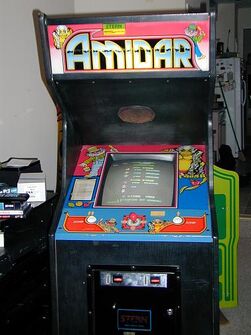
Amidar is an arcade game released in 1981. It was developed by Konami and published by Stern. It is a maze game required to visit each spot on the level. the player moves around a fixed rectilinear lattice, attempting to visit each location on the board while avoiding the enemies. When each spot has been visited, the player moves to the next level. The game and the name have their roots in the Japanese lot drawing game Amidakuji. The bonus level in Amidar is a nearly exact replication of an Amidakuji game and the way the enemies move conform to the Amidakuji rules.[citation nee
Gameplay[]

An abstract arcade game in which players must 'colour in' all of the rectangles on the screen. Each level has a number of patrolling enemies - or 'Amidars' - that must be avoided. Players are aided in their task with the inclusion of a JUMP button which, when used, causes all the on-screen enemies to jump; allowing the player time to escape from a close situation. There are only 3 'jumps' given per level, however.
On even-numbered levels, the player's character is a gorilla; on odd-numbered levels, it is a paint roller. The Amidar enemies are savages and pigs, respectively.
Filling the 4 corner boxes of the screen gives the player a short time in which to chase the Amidars and score extra points. In between levels, there is a chance to earn 5,000 bonus points. Here, a pig moves across the top of the screen. By pushing the jump button, the pig traces a path across the boxes towards the bottom of the screen. If the savage or pig reaches a bunch of bananas, a bonus is awarded.
Enemies[]
The enemies (and bonus stage pigs) in Amidar move deterministically; this is described in the game as "Amidar movement". Each normal-type enemy moves vertically from the top to the bottom of the screen, and then back to the top, and so on. While moving in a constant vertical direction, the enemy will take every horizontal turn available. Each level has one special enemy (the "Tracer", colored white) which, at the beginning of each stage, simply patrols around the perimeter of the gameboard in an anti-clockwise direction. However, following a certain number of "laps", The Tracer will begin to relentlessly pursue the player by following the path their on-screen avatar takes around the level. Since the Tracer moves at the same speed as the player character, but does not mimic any pauses or hesitations the player makes, gameplay now becomes much more frantic, as too many mistakes will allow the Tracer to catch up. Later levels increase difficulty by adding more complex game grids, adding more enemies, and reducing the delay before the Tracer starts pursuing the player, until eventually it starts its pursuit at the very beginning of each new level.
Ports and Copies[]
Being an arcade game Amidar was released on different consoles. It was released on the Atari 2600, and this was the only official port. There were many unofficial and unauthorized clones and ports to the, BBC Micro, Acorn Electron), Microdeal's Cuthbert Goes Walkabout (Dragon 32/64, TRS-80 CoCo, Commodore 64, Atari 8-bit family), Llamasoft's Traxx (Vic-20, ZX Spectrum), Superior Software's Crazy Painter (BBC Micro, Acorn Electron) and Gapper (DOS).
All Time High Scores[]
There are two ROM sets for Amidar. The hard set was distributed by Stern and the easy set by Konami. Twin Galaxies holds the two records played on both ROM's. On Konami's ROM set, a man, Todd Lamb, of Kenosha, Wisconsin, reached an amazing 19,225,030 points. Scott Karasek, of Racine, Wisconsin, scored 3,208,870 points on Stern's ROM set. The date of the score of Konami's ROM was Oct 1, 1983, and the Stern's version high score was set on June 22, 1982.